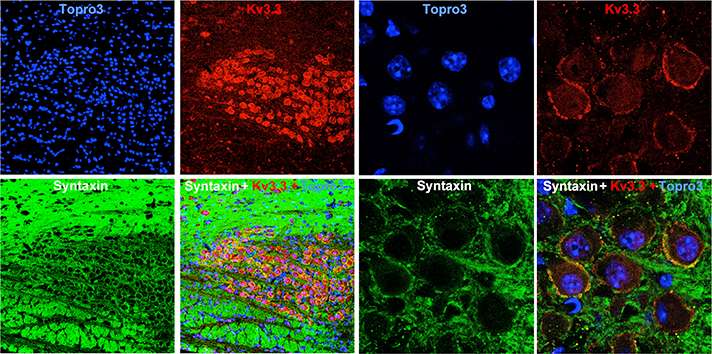Images showing the Kv3.3 potassium channel protein (red), cellular nuclei (blue) and neuronal processes (green) within the brainstem.
The purpose of certain proteins in the brain, known as ion channels, is to regulate how nerve cells fire, or send information. But a Yale-led research team has uncovered a previously unknown function for a particular channel that, when mutated, causes a rare brain disease. Their discovery opens a new avenue for brain research.
Mutations in a channel known as Kv3.3 causes a rare degenerative disease that affects balance and mobility in young patients, even newborns, but that can also begin in middle age. In the study of one mutation, professor of pharmacology Leonard Kaczmarek and his co-authors made some unexpected discoveries. Compared to other channels, the Kv3.3 channel has the ability to build a cytoskeleton, a structure that organizes and shapes cells.
They also found that, in order to do this, the channel interacts with a protein, Hax-1, that governs whether nerve cells live or die. "That was striking," said Kaczmarek. "Channels aren't supposed to interact with cell death proteins. It's a little like suddenly discovering that your best friend has worked as an assassin for the past 20 years."
The study results provide new insight into both an incurable disease and brain function. "The key finding is that a protein that has previously only been thought to regulate how neurons fire has a second job in controlling the activity of proteins that determine whether a cell lives or dies, and that it does so by organizing the structure underneath itself," Kaczmarek noted. "Knowing channels can function this way gives us a new set of targets for research and treatment."
The study was published online March 17 in Cell.
More information: Yalan Zhang et al. Kv3.3 Channels Bind Hax-1 and Arp2/3 to Assemble a Stable Local Actin Network that Regulates Channel Gating, Cell (2016). DOI: 10.1016/j.cell.2016.02.009
Journal information: Cell
Provided by Yale University






















